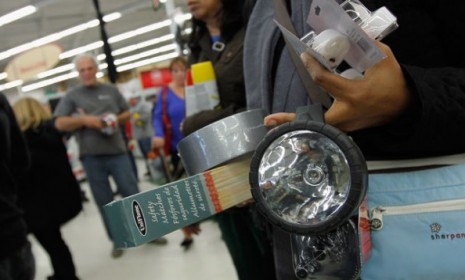How to stay safe during Hurricane Sandy: 7 tips
The perfect storm is barreling down on the Northeast. What can you do to protect yourself, your family, and your home?

Residents of the mid-Atlantic coast are hunkering down for what promises to be a punishing, simultaneous blow from Hurricane Sandy and two blasts of winter weather. Forecasters are warning of high winds that could topple trees and damage homes, a storm surge that could flood low-lying coastal areas, and heavy rainfall or even snow that could create dangerous conditions far inland. The violent weather is also likely to down power lines and leave many of the 50 million people in the storm's path without electricity. What's the best way to stay safe? Here, seven key tips:
1. If you're in a danger zone, get out
When a hurricane comes barreling in, the primary safety rule is quite simple: Get out of the way. "We've seen a lot of people unfortunately get injured and even losing lives going out during storms when they don't need to be out there," says Federal Emergency Management Agency administrator Craig Fugate. Those in the storm's path can stay as safe as possible if they "heed the evacuation orders and stay off the road and out of this weather that comes in."
The Week
Escape your echo chamber. Get the facts behind the news, plus analysis from multiple perspectives.

Sign up for The Week's Free Newsletters
From our morning news briefing to a weekly Good News Newsletter, get the best of The Week delivered directly to your inbox.
From our morning news briefing to a weekly Good News Newsletter, get the best of The Week delivered directly to your inbox.
2. Stay inside
Even if you aren't ordered to leave, "stay indoors and avoid the calmed 'eye of the storm' that can pass quickly, leaving you outside at risk," says Ryan Jaslow at CBS News. Most hurricane-related injuries are caused by flying glass and other debris, and you can avoid getting hit if you hunker down in a safe spot, inside and away from windows and doors. When the winds are at their worst, a bathroom or dry basement can provide the best shelter.
3. If you plan to stay put, be prepared
If you're one of the 50 million Americans who could be affected by the storm, you need to get ready, now, even if you're not being advised to leave home, says Jaslow at CBS News. Stock your home with emergency supplies, including five gallons of drinking water per person (enough for three to five days), non-perishable foods, a battery-powered radio and flashlights, extra batteries, a first-aid kit and manual, prescription medicines, baby food, sleeping bags, extra blankets, and other necessities. Also, have important documents handy — including insurance policies, wills, licenses, and anything "you might need to grab in a pinch."
A free daily email with the biggest news stories of the day – and the best features from TheWeek.com
4. Be careful what you eat
Turn your refrigerator and freezer temperatures to their coldest setting. "When the power goes out, that food in the fridge will last only so long," says ABC News Radio. Once the electricity has been out for four hours or more, "you should throw away any perishable food" you have in the fridge. If your freezer's full, leave it closed and your frozen food should stay safe for 48 hours. If it's only half full, the "safe window" is just 24 hours. And open the door as infrequently as possible, as you let cold air escape every time you open it, "effectively speeding up the clock for when your food might spoil." Use common sense, and toss anything that looks, feels, or smells funny. And always follow the "old rule, 'When in doubt, throw it out.'"
5. Make sure everyday items don't turn dangerous
If you've still got time, you should "trim back trees and shrubbery around your home," says Nashoba Publishing, and get rid of diseased or damaged tree limbs that could be blown down and sent flying by high winds. Clear rain gutters to prevent flooding in the wrong places. And do what you can to prevent items outside your home from being "picked up by strong winds and used as a missile." Make sure storage sheds and kids' playhouses are securely anchored, and bring in loose lawn furniture, hanging plants, trash cans, and other items. If you don't have storm shutters, cover windows with plywood bolted to the surrounding wall.
6. Use your generator wisely
"In a blackout, many view generators as a lifesaver," says ABC News. "But use them improperly, and they can actually put your life in danger." Generators use carbon monoxide, which you can't detect because it's colorless and odorless. Each year, 15,000 people get sent to emergency rooms and 500 people die from carbon monoxide poisoning. "To keep you and those who live with you safe, never use a generator inside your home or garage," even if the windows are open.
7. Listen to people who have been through it
Some of the best tips come from people who have already weathered a monster storm, says Kathleen Koch at CNN. So take note of these helpful pointers from people who lived through Katrina: Open drawers when making a video of your belongings for insurance purposes so you don't miss anything; have a tire plug kit and pliers to pull out nails and other sharp debris to keep you mobile after the storm; text instead of calling to extend your cell phone battery; don't expect safes and safe-deposit boxes to keep your important belongings dry in a flood; and have tarps ready to keep your home dry if wind blows shingles off your roof.
Click here for the Centers for Disease Control and Prevention's guide to hurricane readiness, or here for FEMA's readiness tips.
-
 What role will Trump play in the battle over Warner Bros. Discovery?
What role will Trump play in the battle over Warner Bros. Discovery?Today’s Big Question Netflix, Paramount battle for the president’s approval
-
 ‘The menu’s other highlights smack of the surreal’
‘The menu’s other highlights smack of the surreal’Instant Opinion Opinion, comment and editorials of the day
-
 Education: More Americans say college isn’t worth it
Education: More Americans say college isn’t worth itfeature College is costly and job prospects are vanishing